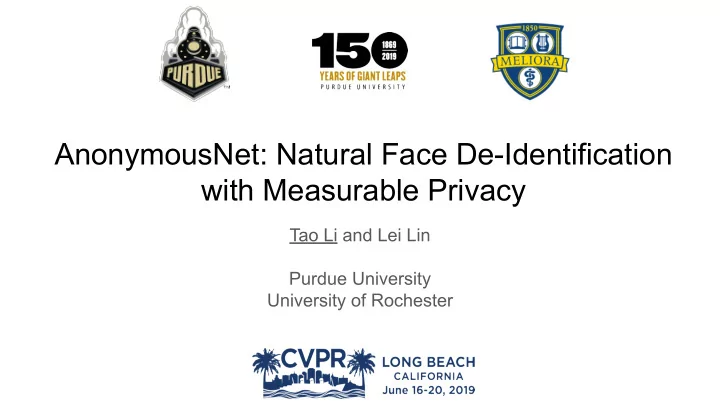

AnonymousNet: Natural Face De-Identification with Measurable Privacy Tao Li and Lei Lin Purdue University University of Rochester
Outline - Motivation & Background - Our Approach: The AnonymousNet - Experiments - Discussion & Future Works
Privacy v.s. Usability
Face Obfuscation
Face Obfuscation DeepFake Nirkin et al. FG'18 Sun et al. CVPR'18
Unanswered Questions - Is it private now? - How private is it? - Can it be more private/usable? - Why?
AnonymousNet: A Natural and Principled Way for Face Obfuscation
Stage-I: Facial Attribute Prediction Using CNN Preprocessing using a Deep Alignment Network (Kowalski et al. CVPR'17)
Stage-I: Facial Attribute Prediction Using CNN
Stage-II: Privacy-Aware Facial Semantic Obfuscation Using CeleA dataset (Liu et al. ICCV'15) as an example.
Stage-II: Privacy-Aware Facial Semantic Obfuscation
Privacy-Preserving Attribute Selection
Stage-III: Natural Face Generation Using GAN Choi et al. CVPR'18
Generated Examples.
Stage-IV: Adversarial Perturbation against Adversaries
Experimental Results
Comparison
Summary - We proposed the AnonymousNet for natural face de-identification. - The framework encompasses four stages: facial feature prediction, semantic-based facial attribute obfuscation guided by privacy metrics, photo-realistic and de-identified face generation, and adversarial perturbation. - Privacy is preserved in a natural and principled manner.
Next Steps - A formally definition of ε-Differential Privacy for facial images. - Principled and end-to-end models for privacy preservation. - Extended frameworks for sequential domains.
Thank you! Poster #134 | @Tao_CS The paper is available on: https://arxiv.org/abs/1904.12620
Recommend
More recommend